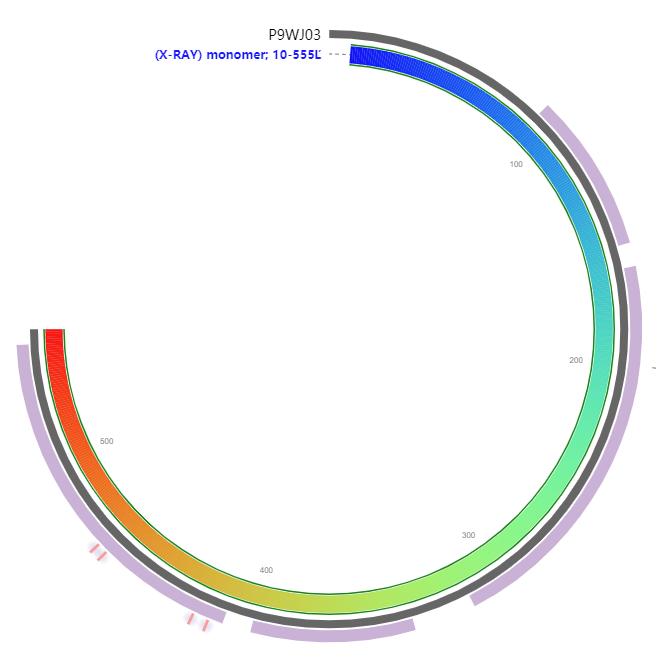Essential protein with sulfite reductase activity required in assimilatory sulfate reduction pathway during both primary and secondary metabolism and thus involved in development and growth.
MTTARPAKARNEGQWALGHREPLNANEELKKAGNPLDVRERIENIYAKQGFDSIDKTDLR
GRFRWWGLYTQREQGYDGTWTGDDNIDKLEAKYFMMRVRCDGGALSAAALRTLGQISTEF
ARDTADISDRQNVQYHWIEVENVPEIWRRLDDVGLQTTEACGDCPRVVLGSPLAGESLDE
VLDPTWAIEEIVRRYIGKPDFADLPRKYKTAISGLQDVAHEINDVAFIGVNHPEHGPGLD
LWVGGGLSTNPMLAQRVGAWVPLGEVPEVWAAVTSVFRDYGYRRLRAKARLKFLIKDWGI
AKFREVLETEYLKRPLIDGPAPEPVKHPIDHVGVQRLKNGLNAVGVAPIAGRVSGTILTA
VADLMARAGSDRIRFTPYQKLVILDIPDALLDDLIAGLDALGLQSRPSHWRRNLMACSGI
EFCKLSFAETRVRAQHLVPELERRLEDINSQLDVPITVNINGCPNSCARIQIADIGFKGQ
MIDDGHGGSVEGFQVHLGGHLGLDAGFGRKLRQHKVTSDELGDYIDRVVRNFVKHRSEGE
RFAQWVIRAEEDDLR
565

| PMID | Title & Author | Abstract | Year | |
| 0 | 8347657 | The ferredoxin:sulphite reductase gene from Synechococcus PCC7942.Gisselmann G, Klausmeier P, Schwenn JD | The structural gene of the ferredoxin:sulphite reductase (EC 1.8.7.1) from the cyanobacterium Synechococcus PCC7942 (formerly 'Anacystis nidulans') was cloned and sequenced. The gene termed 'sir' was detected by heterologous Southern hybridisation with the structural gene cysI from Escherichia coli encoding the iron-sulphur haemoprotein of the NADPH:sulphite reductase. The open reading frame is comprised of 1875 bp encoding for a polypeptide of M(r) 70.028. The deduced amino acid sequence is 35.6% identical with the enterobacterial iron-sulphur haemoprotein. This putative fd-dependent sulphite reductase is only distantly related to the fd-dependent nitrite reductase (binary matching coefficient SAB: 0.23) or with the NADPH-sulphite reductase (SAB: 0.32). Highly conserved residues are found within the two Cys clusters forming the reactive Fe4S4-sirohaem centre of the enzyme. Expression of the si | |
| r gene using a fusion vector gave a single gene product which is immunologically related with the fd-sulphite reductase from the wild-type bacterium. | 1993 | |||
| 1 | 9661674 | Isolation and characterization of a gene for assimilatory sulfite reductase from Arabidopsis thaliana. | Sulfite reductase (SIR) represents a key enzyme in sulfate assimilation in higher plants. The genomic DNA sequence of the sir gene from Arabidopsis thaliana including regulatory and structural regions was isolated and characterized. The sequence of a 6 kb fragment encoding SIR revealed a coding region of 2891 basepairs (bp) that consists of eight exons separated by seven introns between 83 and 139 bp in length. The transcription start point was determined 272 bp upstream of the translation start site. Southern analysis indicates a single locus for the sir gene that gives rise to a 2.4 (kb) mRNA in leaves and in roots. The promoter region was verified by functional expression of the gusA reporter gene in transgenic A. thaliana plants and was shown to provide correct expression in root and leaf. | 1998 |
| 2 | 28057796 | Characterization of two ferredoxin-dependent sulfite reductases having different substrate specificity in the red alga Cyanidioschyzon merolae.Kohsuke Sekine , Takashi Moriyama , JuYaen Kim, Toshiharu Hase , Naoki Sato | Assimilatory sulfite reductase (SiR) and nitrite reductase (NiR), which are important determinants in biomass productivity, are homologous enzymes that catalyze the reduction of sulfite to sulfide and nitrite to ammonium, respectively. They have a siroheme and a [4Fe-4S] cluster as prosthetic groups in common. The red alga Cyanidioschyzon merolae encodes two SiR-like enzymes, CmSiRA and CmSiRB, which are likely products of recent gene duplication, but no homologues of NiR. The growth in a medium containing nitrate, however, must be supported by a nitrite reducing activity. CmSiRB was not detected in the ammonium medium, but, in the nitrate medium, it was present at a level 1/6 of that of constitutively expressed CmSiRA. Kinetic analysis of the two enzymes showed that CmSiRA has high kcat values with both sulfite and nitrite, but CmSiRB has virtually only the activity of nitrite reduction, although the Km value against nitrite was fairly high in both enzymes. The six amino acid residues that are specific to CmSiRB among various SiR-like enzymes in the active site were mutagenized to mimic partially CmSiRA. Among them, the mutation S217C in CmSiRB partially recovered sulfite reduction activity, suggesting that this residue is a major determinant of substrate specificity. | 2017 |
Gisselmann G , Klausmeier P , Schwenn J D . The ferredoxin:sulphite reductase gene from Synechococcus, PCC7942[J]. Biochim.biophys.acta, 1993, 1144(1):102-106.